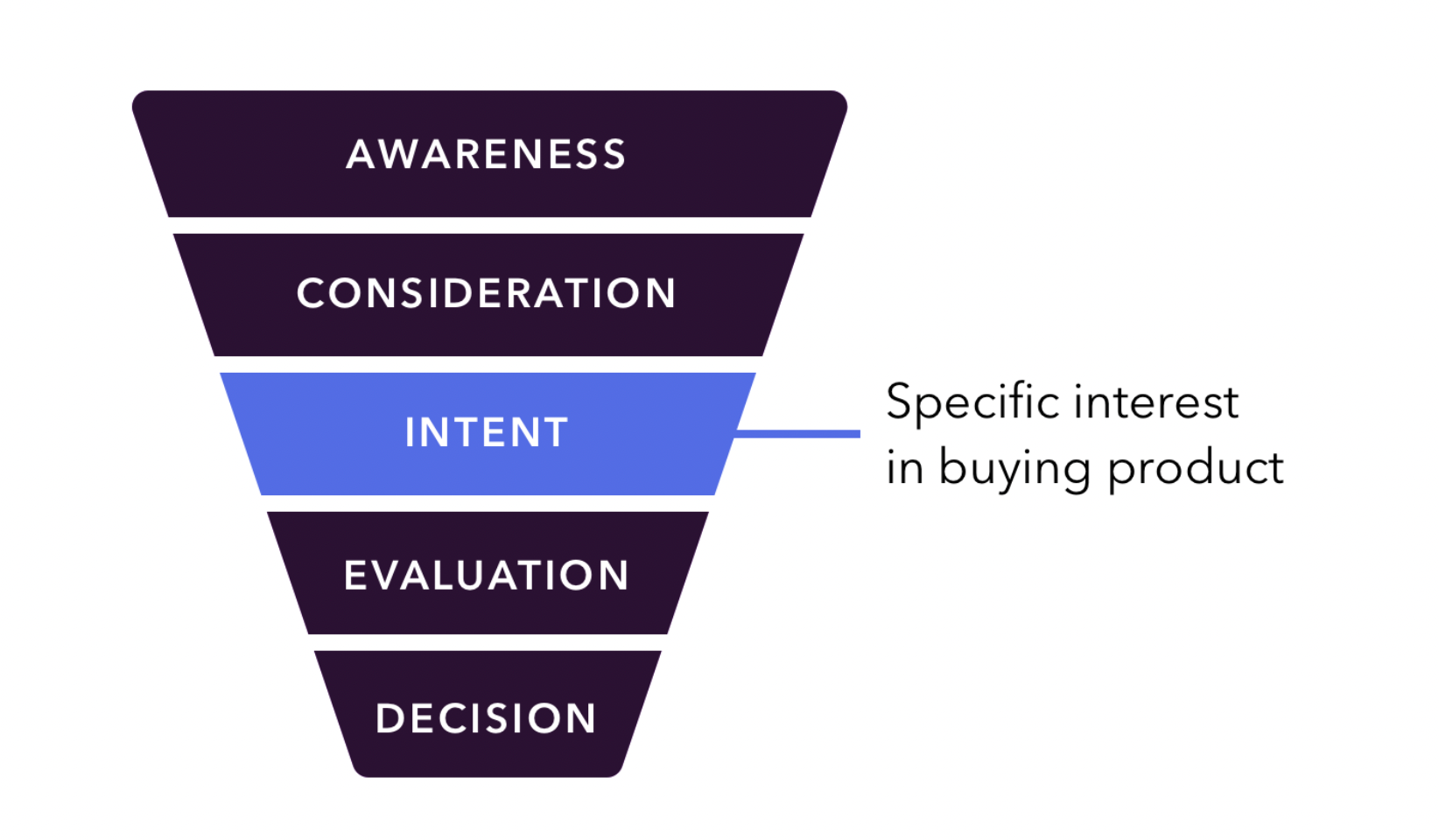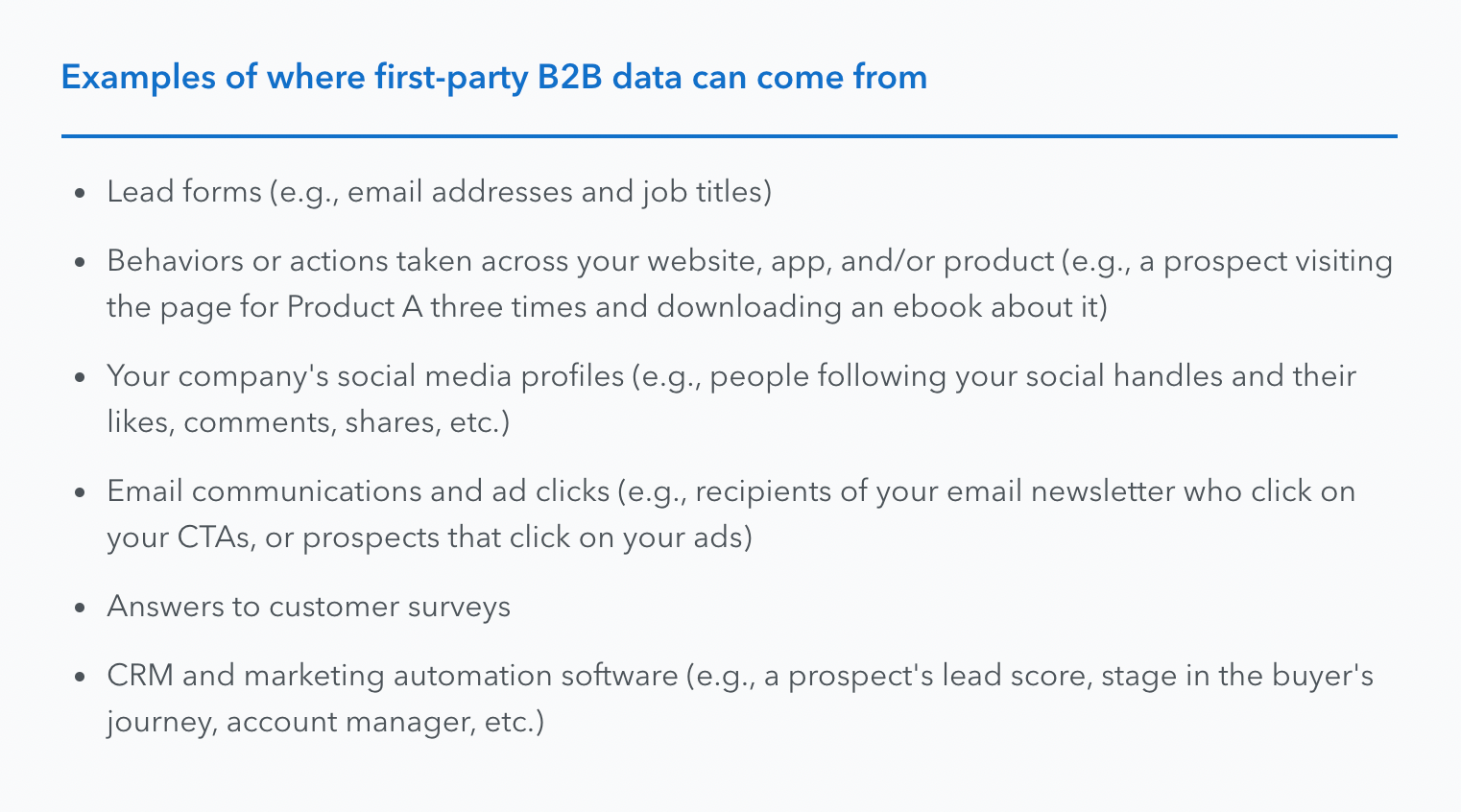A marketer’s guide to B2B intent data
Today most B2B buyers are nearly through the customer journey before they ever reach out to a salesperson. In fact, B2B buyers spend about 83% of their time independently researching — both online and offline — before making a purchase according to Gartner.
So what’s the best way to reach these prospective buyers while they’re doing research? By using intent data. It’s a B2B marketer’s best friend, and more marketers are taking advantage of it. By the end of 2022 (i.e. this year), over 70% of B2B marketers will be using intent data to target prospects and key accounts.
If you’re a B2B marketer who’s not using intent data, you’re missing out on a key lever to increase a buyer’s chances of converting. The good news is, we’ve put together this guide on how to use intent data in B2B marketing to help you get started.
What is B2B intent data?
Simply put, B2B buyer intent data provides insight into whether someone is considering buying your product. Intent data gives you an inside look into prospects’ buying signals, whether they’re obvious or subtle, so you can position your product to be the best option. These buying signals can include researching your industry’s keywords, booking a demo, or downloading a report.
Combining intent data with the firmographic details of your ideal customer profile (ICP) gives further definition to your targeting. Your ICP shows who you want. Intent data shows who wants you. When the prospect you want wants you back, it’s a perfect match.

Buyer intent in B2B can be visible or hidden
People show their intent all the time when they browse web pages. That’s how web analytics tools can provide rich background data to deepen your understanding of potential buyers.
Visible intent can include prospects visiting your website and filling out a form.They’ve made their intent known by providing their contact information. Visible intent can also include people visiting related websites, such as a competitor’s website, or reading product reviews and filling out a form with their contact details on the review site. They become visible to the third-party site owner, and data vendors can supply that information to B2B marketers.
Most B2B web traffic is anonymous, however, so intent signals are usually hidden. Hidden intent includes people who visit your website, take a look around, and leave or visit other websites that are not directly related to your product but relevant to the buyer’s journey. A great way to uncover hidden intent data is by de-anonymizing web traffic to reveal IP addresses.
Learn more about the different kinds of signals behind intent data, including behavioral and contextual data.
Types of B2B intent data
Intent data falls into two categories: first-party (internal) and third-party (external) data. Both enable B2B marketing and sales teams to see a complete picture of a target account’s activity.
Combining internal and external intent data gives you full context and clarity on the buyer’s journey, so you can make actionable decisions that turn more prospects into customers.
First-party intent data
First-party intent data, or internal intent data, is data that is readily available within your company’s systems and tools. It can include data from website traffic, social media listening tools, internal searches, and other systems. When you think about tracking visitors on your website or your prospective buyer’s activity online, you’re essentially thinking about getting first-party intent data.
First-party intent data is particularly valuable for marketers because it shows strong buying signals. It’s also easier to take action on first-party intent data in real time. While Google Analytics will reveal interesting trends, like what browsers people use or what country they’re in, first-party intent data is especially powerful in a B2B context. That’s because it indicates a buyer’s interest in your products or services based on their behavior, like a target account filling out a contact form or visiting your pricing page multiple times. If you’re not taking full advantage of first-party intent data, you could be leaving potential pipeline (and revenue) on the table. Using intent data internally gives you control over what you collect — and how — and allows you to act on the data immediately once it’s collected.
Chances are, your team is probably already tracking first-party intent data through website analytics tools, CRM tools, marketing automation platforms, or your website’s backend. You just need to turn that raw data into intelligence to enhance your buyer journey.

Third-party intent data
Third-party data, or external intent data, is data that is not readily available in your own systems. Rather, it’s sourced from external parties. Since external intent data doesn’t consider the whole customer journey, it doesn’t always show strong buying signals.
Third-party intent data, however, still serves a purpose. Customers rarely visit a website just once when making a buying decision. They check out similar products (often your competitors’) and also read reviews. The majority of this research might even happen before a buyer talks to one of your sales reps.
By observing buyer behavior all over the web, third-party intent data can give you a more comprehensive picture of your prospects’ activities. Review sites such as G2 can provide a list of companies that searched for your product, your competitors’ products, or your product category in general. If you’re only relying on data from prospects visiting your site or downloading your content, you’re missing the potential customers who are researching just your competitors.
B2B marketers can obtain third-party intent data from data platform providers and aggregators who collect information from multiple sources. Competitors can also purchase much of this data and get access to the same information, so creating unique targeting and rising above the noise becomes more challenging.
It can also be difficult to find out which platforms (like G2 and others) provide quality third-party intent data. Be sure to do your research and ask the right questions to find a great vendor for third-party intent data.

How to use intent data in B2B marketing
“The wider the net, the more fish we’ll catch” is a mentality that might work for fishermen, but that’s not the case for B2B marketers. To win more customers, you need to deliver personalized experiences and create deeper connections with prospects throughout the entire buyer journey. Intent data gives you the insights to do just that.
Optimize the customer journey for buyers
Every website interaction is an opportunity to make a good impression, and intent data can help you tailor headlines, calls to action, and even chat conversations so that they’re as relevant as possible to your website visitors. For example, when a target account with fewer than 100 employees visits your website, you can display copy that’s written specifically for small businesses.
You can also personalize purchase journeys by observing visitors’ engagement patterns using intent data. For instance, let’s say someone goes from reading product updates on your blog to checking out the pricing page while also going back and forth between G2, Product Hunt, and other product review sites in just a couple of days. This can indicate that they’re ready to buy but aren’t entirely convinced yet. Thanks to intent data, you’re aware of these buying signals, and you can send personalized product reviews or case studies their way.
Personalizing website chats can also help turn a website visit into a conversation. For example, your product helps companies close sales deals faster, and you’re tracking IP addresses to capture intent. With this intent data, you could personalize the welcome message in your chat so that when a target account visits the website, they’ll see something like, “Trying to close deals faster? You’ve come to the right place.” Non-target accounts instead might see a generic message, like “Hello, how can I help you today?”
By focusing on accounts showing the highest intent, B2B marketers can cut through the inbound noise and create specific, relevant experiences for their most important audiences. For example, you can use Clearbit Advertising to narrow down accounts you want to target with Facebook Ads and trigger the ads after the account shows buying intent. To drive broader awareness, you can send the ads to everyone who works at that particular company. This approach reduces advertising spend while increasing conversion rates.
Find out how Chargebee grew its new pipeline by 300% with full-funnel intent-based marketing.
Build informed account-based marketing strategies
Data matters a lot in account-based marketing (ABM). Not just ordinary data, but high-quality data that provides accurate information on target accounts.
Account-based marketing helps B2B marketers focus marketing efforts on their best-fit accounts. But accounts don’t sign off on the sale — individuals do. Intent data can contextualize the roles of everyone who’s involved in the buying process, so you can select the right accounts to focus on.
With intent data, you can discover customers who are actively looking for products or solutions like the ones you offer. They may have posted about them on social media sites like Twitter and LinkedIn, posted on popular industry forums, or commented on other sites. If you’re leading an ABM strategy, having this information at your fingertips can help you grow your list of accounts and fill that list with interested prospects who are more likely to engage in sales conversations.
Once you’ve identified target accounts, the next step is to tailor engagements to the specific needs of those accounts. Intent data lets you know which product and service categories your target accounts are actively researching and whether they’re interested in competing products. You can then use this intent data to find out when target accounts are on your website and prioritize outreach based on their behavior. By analyzing intent data, you can also tailor content to reach different individuals associated with the account at any stage of the sales funnel.
Uncover hidden opportunities for sales
People are visiting your website every day, but how many are filling out forms or trying to talk to one of your sales reps? Many of these visitors are likely interested in your product, but unless they submit a contact form, you have no idea who’s browsing. If you aren’t tracking website visitors, you might never know when a target account shows up on your site website. And if visitors bounce from your site, your sales team misses out on potential opportunities.
That’s where intent data comes in. Instead of waiting for website visitors to show intent by filling out a form, you can use intent data to alert sales when a target account visits your website. This way, your sales reps can spring into action, prepare personalized messages for any scenario, and start putting together a strategy for winning that deal.
To uncover the best opportunities for your sales team, you can set parameters to define high-interest and high-purchase intent. For example, a high-interest visitor could be a target account that views your website twice in one day. When purchase intent is high, it’s essential to have a system that notifies your marketing and sales team to reach out with a personalized approach. If a prospect falls out of communication, your website’s intent data can notify reps when they return to your site. This intent intelligence lets reps know when to re-engage the account at the right time.
Discover 10 different ways to use alerts intelligently and boost sales success.
Create precise ad targeting
A large percentage of B2B vendors are already using intent data to support digital marketing and inform retargeting. That’s because intent data helps you leverage search topics and context.
With intent data, you can create laser-focused search and display ads. Intent data lets you know why your potential buyer is searching for your solution. Once you understand their intent, you’re more equipped to accelerate their buying journey and move them towards a purchase faster. By helping you understand a prospect’s online behaviors and related interests, intent data makes it possible to serve hyper-targeted ads that are more likely to resonate.
Capturing buying intent signals can also help you deliver well-timed retargeting ads with customized CTAs and messages. You can maximize performance by making data-driven decisions about where your ads will be placed. So instead of annoying prospects or coming off as creepy, your retargeting campaigns will reach prospects with the right purpose, intention, and value.
Accelerate pipeline by learning how to improve win rates and close deals faster with targeted advertising.
Analyze and attribute content to maximize ROI
Being able to connect or attribute content to tangible business outcomes is one of the joys of B2B marketing. It’s one thing to know that the content on your website is attracting readers, and it’s another to know that those readers fit your ideal customer profile. Even better? Knowing that your readers are moving further down the buying funnel.
To get insight into what content is working (and what’s not), de-anonymize your website traffic to determine what percentage is coming from a target account and which pages they engage with the most. Using this data, you can create additional content that your buyers are looking for. Which topics are your target accounts consuming the most? What other content can you create about these topics that move buyers through the funnel? Knowing the specific things your target audience cares about — as opposed to just having a broad understanding — will help you create more effective content.
If you have limited content resources, intent data is your secret weapon. By analyzing and filling the content gaps in your marketing, you can focus on producing content that will resonate with your audience. And depending on the buying signals you’re seeing, you might even be able to recycle or repurpose existing content to appeal to prospects.
Make intent data work for you
Understanding your buyer’s intention can unlock more pipeline and new possibilities. But intent data can only go so far if it’s not used strategically. Simply having a list of people who’ve shown buying signals and randomly reaching out to them with generic content, ads, or emails won’t win you more customers.
Remember that intent is dynamic — it changes over the course of a buyer’s journey. At first, a prospect will want to know if your product can solve their problem. When they are ready to make a purchase, they’ll want to know more about your customer service and support offerings.
Using intent data requires a comprehensive strategy, including the means to gather it, qualify it, and a clear plan on how you’ll use it. A well-thought-out intent data strategy, implemented with creativity and rigor, will make intent data work for you — and help you turn more prospects into customers.
Want to learn more about using data in your marketing programs? Dive into Data Essentials I for a primer on all the data types you need to master as a data-driven marketer.

